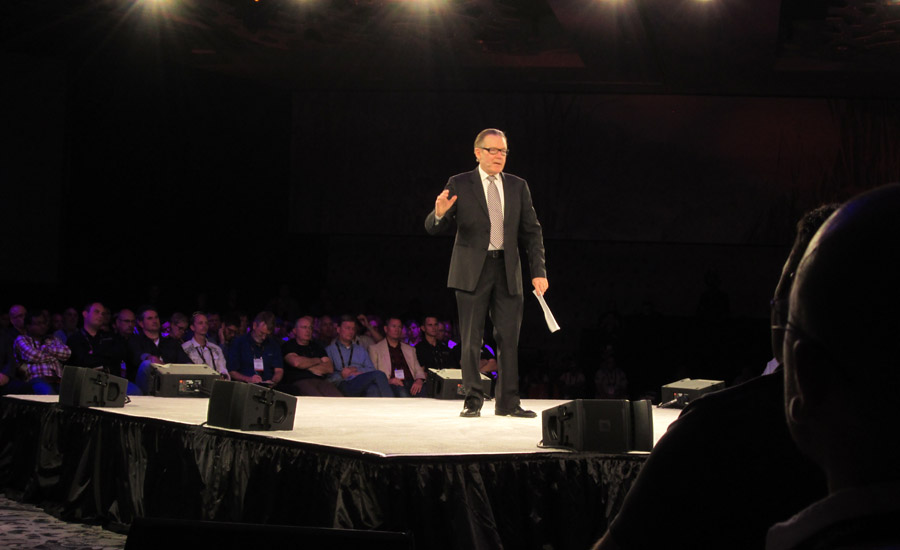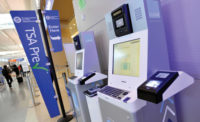The Future Home Experience keynote address that kicked off CEDIA EXPO 2015 brought the flying car-type concepts of the future to within grasp in the next few years.
First, Richard Millson, founder of Vancouver-based Millson Technologies, briefly looked back at past CEDIA EXPOs and its 25-year anniversary in 2014. He recounted how the convention has grown from its incipient meeting in a small Chicago room in 1989 to the more than 3,500 member companies it now boasts. But the focus quickly changed to the evening’s theme — the future home experience — as Millson unveiled the new CEDIA logo and described the plans for CEDIA Talks and other new features at the CEDIA booth.
Over the next 25 years, Millson said, CEDIA wants its members to focus on how they will bring people the best days of their lives. Part of that, he said, requires members to understand culture, social trends and technology. With that, Millson introduced the evening’s speaker, Michael Rogers, the Practical Futurist.
Rogers was the Futurist in Residence at The New York Times and is a columnist for MSNBC.com. Starting by citing Moore’s Law of the ever-increasing trend toward more transistors per square inch on integrated circuits and Metcalfe’s Law of the proportional value of telecommunications networks to the square of the number of connected users of the system, Rogers demonstrated with examples such as Uber and the introduction of the fax machine that many seemingly far-off technologies are really at the cusp of veritable explosions.
Rogers made several predictions, all of which he said will be a regular part of life in the early 2020s. First, we will lead more virtualized lives in which we will never be disconnected from the Internet. Wearable computers — despite the letdown of the Google Glass, Rogers said — are inevitable by the early ‘20s. With bone transducers that will allow users to hear sound in their heads while at the same time picking up the users’ commands — even those in a hushed whisper — these new, handsomer glasses will truly be useful in ways such as recognizing someone approaching and reminding the wearer of the person’s name, all while projecting an image that will seem to the wearer as if a 50-in. screen is in front of her.
Big screens will be everywhere, and they will be cheap, Rogers said. He described ambient telepresence, or technology that fills a wall with a screen and projects a room from thousands of miles away so that people in both rooms feel as though they are interacting with each other in actual physical proximity.
Virtual reality will be popular, especially among young people. The differences between wireless and wired broadband will be blurred as wireless surges to blazing speeds and networks overlap so that people will seamlessly pass from their home network to their car network to their work network without ever leaving the Internet. In fact, Rogers said, “We will have to teach kids what ‘offline’ means.” Everything will work better when connected to the Internet. “Kids will worry about losing Wi-Fi more than they will losing electrical power,” he said.
Another existing technology that will become a ubiquitous and useful part of life is smart sensors. Chips as tiny as a baby’s fingernail can measure anything; they will be powered completely by energy harvested from the environment or from body heat. Some examples Rogers gave of these smart sensors already being used were chips in the surfaces of bridges that sense when ice is beginning to form and alert authorities (and will soon alert drivers); these sensors are powered by the flexing of the bridge alone. Also, several European companies have begun using smart dumpsters that can communicate with drivers how full they are and can even tell what kind of trash is in them, something that could be helpful in stopping illegal dumping. One company even gave its dumpsters Twitter accounts in case anyone is curious about what a smart dumpster is thinking. The possibilities are endless without even mentioning the health and life safety benefits. Imagine a baby monitor that senses movement and communicates with the baby bottle warmer, Rogers said.
Facial recognition was the next technology Rogers discussed. He described a smart home that not only recognized the homeowner and family members, but could also recognize what kind of mood they were in. “Houses will have personalities, and they will guess what you are doing,” Rogers said.
Generation Z has the ability to make and maintain virtual relationships in a way many older generations — even their older siblings — might not be able to understand, Rogers explained.
In summation, we will have digital personalities that will travel with us and inform services around us. Social networks, which thus far have remained mostly siloed, will begin to integrate. “They will become not just a way to market ourselves,” said Rogers, “but a way to organize information.”
The final point he discussed was the imminent market for “luxury software.” Luxury software will differentiate itself from what we are using now in that it will boast extreme ease of use, privacy and security. People will pay for a service that keeps their information private and secure, and Rogers anticipates a growing market for high-end online privacy.
Finally, Rogers stressed the importance of focusing on R&D. And CEDIA EXPO is loaded with the latest innovations and market surges in all types of future smart home technologies. While attendees reflected on the past 25 years, the real focus was on the future — and for the connected home, the future is here. Our cars might not be flying, but they sure are getting smarter.




